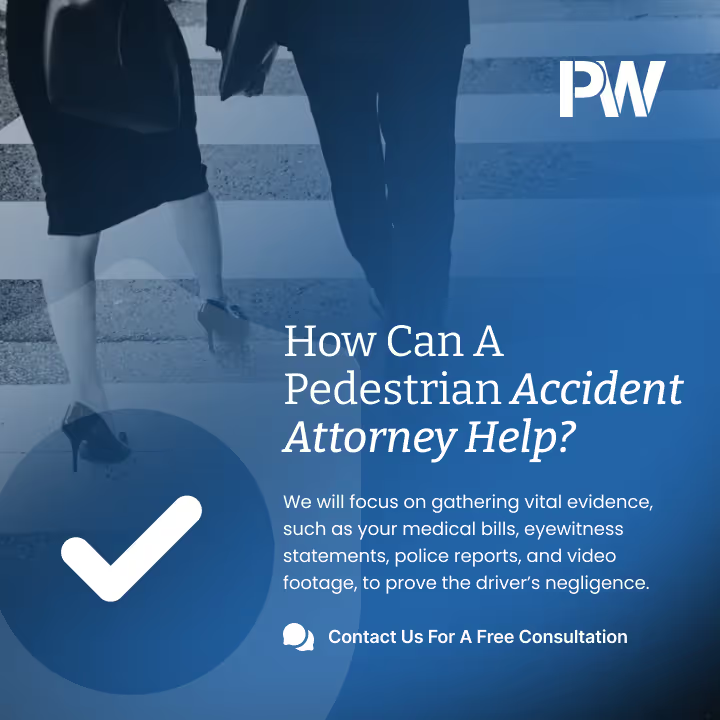Understanding Pedestrian Accidents and Your Legal Rights
Pedestrian accidents occur when a vehicle strikes someone on foot. These collisions happen at intersections, crosswalks, parking lots, and along roadways. Unlike vehicle occupants who have airbags and structural protection, pedestrians face the full force of impact with little protection.
Drivers have a legal duty to exercise reasonable care and avoid hitting pedestrians. This duty includes:
- Maintaining safe speeds in pedestrian areas
- Yielding the right of way at crosswalks and intersections
- Avoiding distracted or impaired driving
- Keeping their vehicles under control at all times
When drivers fail to meet this duty and cause pedestrian accidents, they become liable for damages. Pedestrians have the right to pursue compensation through insurance claims or lawsuits. Understanding your rights after an accident is the first step toward recovery. According to the National Highway Traffic Safety Administration (NHTSA), pedestrian safety is a critical public health concern, with thousands of pedestrians injured annually in traffic accidents.
Common Causes of Pedestrian Accidents
Pedestrian accidents result from driver negligence, reckless behavior, or failure to follow traffic laws. The most common causes include:
- Distracted Driving: Drivers texting, using phones, or looking away from the road fail to see pedestrians. Distracted driving is one of the leading causes of pedestrian accidents and can result in serious liability.
- Speeding: Excessive speed reduces reaction time and increases impact force
- Failure to Yield: Drivers ignoring traffic signals or pedestrian right of way cause intersection collisions
- Driving Under the Influence: Impaired drivers have slower reaction times and poor judgment. DUI-related pedestrian accidents often result in severe injuries and significant liability.
- Poor Visibility: Accidents occurring at night, in bad weather, or in areas with inadequate lighting
- Improper Lane Usage: Drivers drifting into pedestrian areas or turning without checking for pedestrians
- Intersection Violations: Running red lights, failing to stop at stop signs, or turning without looking
Understanding what caused your accident helps establish driver liability and strengthens your claim for compensation. The Centers for Disease Control and Prevention (CDC) provides comprehensive data on pedestrian injury prevention and safety strategies.
Catastrophic Injuries and Fatalities in Pedestrian Accidents
Pedestrian accidents frequently result in severe, life-changing injuries. Unlike vehicle accidents where occupants have protection, pedestrians absorb the full force of collision. The injuries sustained often require extensive medical treatment, rehabilitation, and long-term care.
Common catastrophic injuries from pedestrian accidents include:
- Traumatic Brain Injuries (TBI): Ranging from concussions to severe brain damage causing cognitive impairment, memory loss, personality changes, and permanent disability. Traumatic brain injuries require specialized legal representation to ensure full compensation for lifetime care needs. The Brain Injury Association of America provides resources on TBI recovery and support.
- Spinal Cord Injuries: Resulting in partial or complete paralysis, loss of sensation, and permanent mobility limitations. Spinal cord injuries from pedestrian accidents often require extensive rehabilitation and ongoing medical care. The National Spinal Cord Injury Statistical Center tracks data on spinal cord injury outcomes and recovery.
- Multiple Fractures: Broken bones throughout the body requiring surgery, pins, plates, and extensive rehabilitation
- Internal Organ Damage: Injuries to the liver, kidneys, lungs, or other organs causing life-threatening complications
- Amputations: Loss of limbs requiring prosthetics, ongoing medical care, and complete lifestyle adjustment
- Severe Lacerations and Disfigurement: Permanent scarring and tissue damage affecting appearance and psychological well-being
- Crush Injuries: Tissue damage from being trapped under vehicles causing compartment syndrome and potential amputation
Beyond physical injuries, pedestrian accident victims often suffer emotional trauma, PTSD, depression, and anxiety. The psychological impact of surviving a life-threatening accident can be as debilitating as physical injuries.
Tragically, many pedestrian accidents result in death. Wrongful death claims allow surviving family members to pursue compensation for their loss, including funeral expenses, lost financial support, and the emotional devastation of losing a loved one. Our firm has extensive experience handling wrongful death cases and understands the unique challenges families face.
How a Pedestrian Accident Law Firm Can Help Your Case
Handling a pedestrian accident claim requires specialized knowledge and resources. Insurance companies employ teams of adjusters and lawyers to minimize payouts. You need experienced legal representation to level the playing field.
Parker Waichman LLP provides comprehensive legal services for pedestrian accident victims:
- Thorough Investigation: We investigate accident circumstances, gather police reports, obtain surveillance footage, and identify witnesses
- Evidence Collection: Our team preserves critical evidence before it disappears, including vehicle damage photos, scene documentation, and medical records
- Expert Consultation: We work with accident reconstruction experts, medical professionals, and economists to establish liability and calculate damages
- Insurance Negotiation: We handle all communications with insurance companies, countering lowball offers and fighting for fair settlements
- Litigation Preparation: If settlement negotiations fail, we prepare your case for trial with experienced trial attorneys
- Client Support: We keep you informed throughout the process and provide compassionate guidance during your recovery
Our team includes experienced personal injury attorneys who specialize in complex litigation and have recovered billions for injured clients. We understand the nuances of pedestrian accident cases and know how to build compelling arguments for maximum compensation.
Similar Accident Cases We Handle
Our injury lawyers provide focused legal help for the full range of accidents and injuries. Find the specific topic that matches your situation:
Ready to discuss your case? Call us to schedule your free consultation today: (516) 466-6500.
Frequently Asked Pedestrian Accident Questions
First, seek medical attention for any injuries, even if they seem minor. Call police to report the accident and obtain a police report number. Document the scene with photos if possible, collect contact information from witnesses, and preserve evidence. Avoid discussing fault or signing documents from insurance companies. Contact a pedestrian accident attorney as soon as possible to protect your rights.
The statute of limitations varies by state, typically ranging from one to six years from the accident date, with most states allowing two to three years. Some states have shorter deadlines of one year, while others allow up to six years. It is critical to consult with an attorney immediately to determine your state’s specific deadline.
Many states follow comparative negligence rules, allowing recovery even if you were partially at fault. Your compensation is reduced by your percentage of fault. For example, if you were 20% at fault and damages total $100,000, you could recover $80,000. An experienced attorney can argue against unfair fault assignments and maximize your recovery.
You can recover economic damages (medical expenses, lost wages, rehabilitation costs), non-economic damages (pain and suffering, emotional distress), and in wrongful death cases, funeral expenses and loss of support. The specific damages depend on your injuries, medical treatment, lost income, and the accident’s impact on your life. Our attorneys have successfully recovered compensation for catastrophic injuries, medical malpractice, and other serious harm.
Parker Waichman LLP works on a contingency fee basis. You pay no upfront fees, and we collect a percentage of your settlement or verdict only if we recover compensation. This means you can afford quality legal representation regardless of your financial situation. Contact us today for a free consultation with one of our experienced personal injury lawyers.
Contact Our Pedestrian Accident Attorneys
If you or a loved one has been injured in a pedestrian accident, do not delay seeking legal representation. The decisions you make in the days and weeks following an accident significantly impact your case’s outcome.
Contact Parker Waichman LLP today to schedule your free consultation. Call (516) 466-6500 or schedule an appointment online to arrange a time that works for you. We are available 24/7 to serve injured pedestrians and their families.
Remember: No recovery, no fee. We only succeed when you receive the compensation you deserve. Let our experienced pedestrian accident attorneys fight for your rights and help you move forward after this traumatic event.
Call Parker Waichman LLP now or schedule your free consultation online.



















